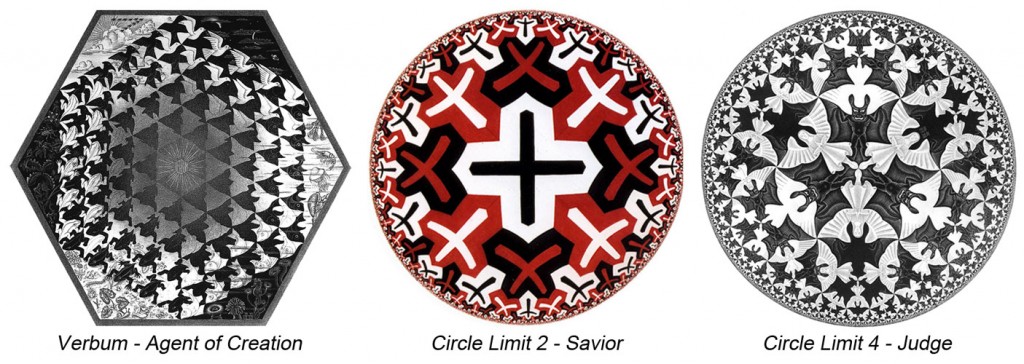 Let’s summarize the Christian content found in Escher’s mandalas.
Let’s summarize the Christian content found in Escher’s mandalas.
In the print Verbum we have Christ’s role as the agent of Creation.
In Circle Limit 2 we have Christ’s role on the cross as the savior of mankind.
In Circle Limit 4, we have Christ’s role as the final judge of mankind.
Note how Escher’s Verbum print and the series of Circle Limit prints show an evolution or transformation from a central point to the infinite as one moves from the center of the print to the outer radius.
In a Letter to his son George and daughter-in-law Corrie, February 4, 1962, Escher writes: “We are all just bits of the Evolution (to quote Teilhard) and if he is right then that evolution will end in millions of years in the mysterious ‘Omega point.’ And yes, why not?”
I believe Escher is quoting, and slightly paraphrasing, from The Phenomenon of Man written by Pierre Teilhard de Chardin. Teilhard was an ordained Jesuit priest and a trained paleontologist. He wrote extensively and is best known for The Phenomenon of Man. Teilhard’s works seek to reconcile Christianity and the theory of evolution.
For Teilhard, the Omega point is the point where mankind converges with the Divine. As Teilhard writes in Hymn of the Universe “Christ is the end point of the evolution…”, or again in The Divine Milieu: “…the incorporation of every elected spirit with Jesus Christ.”, or as Jesus states in Revelation 22:13: “I am the Alpha and the Omega, the first and the last, the beginning and the end.”
Teilhard’s books would have been available to Escher during the time of his work on Circle Limits 1 through 4. They were recent publications and would have represented very new thinking in the late 1950’s and early 1960’s.
Escher’s quote summarizes, as best as can be done in a single sentence, the gist of Teilhard’s broad thought. Given Escher’s fascination with nature, the beauty he found in creation, his love of order out of chaos, and finally, the desire to grow himself, I am not surprised that Teilhard’s work resonated with Escher.
Put more simply, both Teilhard and Escher appreciated creation and found God in it.
In part 8 we look at Escher’s final print.
